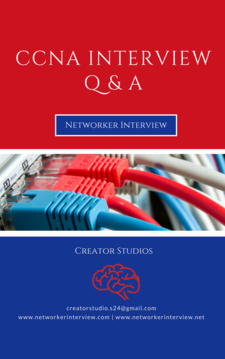What is Routing?
The function of routing is to route packets between networks that are not locally attached.
What is a Router?
A Router is a networking device that performs routing which means it routes packets between devices that are on different networks.
A router is a Layer 3 device.
What are the different types of memory in the router?
RAM - Running configuration file: running-config is stored in RAM
NVRAM - Startup Configuration file: startup-config is stored in NVRAM
Flash Memory - IOS is stored in Flash Memory
ROM - Instructions for POST, Bootstrap program, Mini-IOS is stored in ROM
What are the possible locations of IOS image?
FLASH and TFTP Server.
What is ROM Monitor?
If the Bootstrap program is not able to find a valid IOS image, it will act as ROM Monitor.
ROM Monitor is capable of performing certain configuration task such as:-
1. Recovering a lost password
2. Changing the configuration register value etc.
3. Downloading IOS image using TFTP
What are the different modes in the router?
1. User Exec Mode - In User Exec mode, we can only view the configuration settings on the device but cannot make any changes to the device configuration. IOS prompt in
user exec mode is Router>
2. Privilege Mode - In Privilege mode, we can both view and make changes to the configuration of a router. IOS prompt in Privilege Mode is Router#
Command to navigate to privilege mode from user exec mode:-
Router>enable
Router#
3. Global Configuration Mode - In Global Configuration mode we can make global changes. Global changes are the changes which affect the router (device) as a whole such as changing the hostname of a device. IOS prompt in Privilege Mode is Router (config) #
Command to navigate to Global Configuration mode from Privilege mode:-
Router# configure terminal
Router (config) #
4. Specific Configuration Mode - We can navigate to a number of sub prompt from global configuration, such as the interface prompts to configure the properties of a specific interface and the router mode to configure routing protocols. IOS prompt in specific configuration mode for interface prompt is Router (config-if) #
Example:-
Router (config) # interface fa0/0
Router (config-if) #
What is the command to enter PRIVILEGE mode from USER mode?
> enable
What is the command to enter Global Configuration mode from PRIVILEGE Mode?
# configure terminal
What is the command to reboot a router?
# reload
What is the command to backup IOS to TFTP server?
# copy flash tftp
What is the command to copy running-config to startup config?
# copy running-config startup-config
What is the command to display the current running configuration?
# show running-config
Define static routing?
In static routing, routes are manually configured on the router by a network administrator.
Advantages:-
1. There is no overhead on the router CPU.
2. There is no bandwidth usage between routers.
3. It is secure as the administrator can choose to allow routing access to certain networks only.
Disadvantages:-
1. The administrator must really understand the internetwork and how each router is connected in order to configure routes correctly.
2. It is not feasible in large networks because maintaining it is a full-time job.
What is Default Route?
A default route specifies a path that the router should take if the destination is unknown. All the IP datagrams with unknown destination address are sent to the default route.
What is a Dynamic Routing?
In Dynamic routing, routes are learned by using a routing protocol. Routing protocols will learn about routes from other neighboring routers running the same routing protocol. Example- OSPF, EIGRP, RIP.
What is a Routed Protocol?
A Routed Protocol carries data from one network to another network. Routed protocol carries user traffic such as file transfers, web traffic, e-mails etc.
Example- IP (Internet Protocol), IPX (Internetwork Packet Exchange) and AppleTalk.
What is Routing Protocol?
Routing Protocols learn the routes and provide the best routes from one network to another network.
Example - RIP (Routing Information Protocol), EIGRP (Enhanced Interior Gateway Routing Protocol) and OSPF (Open Shortest Path First).
What is IGP?
An Interior Gateway Protocol refers to a routing protocol that handles routing within a single autonomous system. Example- RIP, IGRP, EIGRP, and OSPF.
What is EGP?
An Exterior Gateway Protocol refers to a routing protocol that handles routing between different Autonomous Systems (AS). Example:- Border Gateway Protocol (BGP).
What is an Autonomous System?
An Autonomous System (AS) is a group of networks under a single administrative control.
What is Administrative Distance (AD)?
Administrative Distance is the trustworthiness of a routing protocol. Routers use AD value to select the best path when there are two or more different routes to the same destination learned through two different routing protocols.
What is the Range of AD values?
0 to 255, where 0 is the Best and 255 is the worst.
Routing Protocol Administrative Distance Value
Directly Connected 0
Static route 1
EIGRP 90
OSPF 110
RIP 120
What is Distance-Vector Routing Protocol?
Distance vector routing protocols use the distance or hops as the metric to find paths to destinations.
Example- Routing Information Protocol (RIP), Interior Gateway Routing Protocol (IGRP)
What is Link-State Routing Protocol?
Each router running a link state routing protocol originates information about the router, its directly connected links, and the state of those links. This information is sent to all the routers in the network as multicast messages.
Link-state routing always tries to maintain full networks topology by updating itself incrementally only when network topology changes. Example- Open Shortest Path First (OSPF)
What is Hybrid Routing Protocol?
A Hybrid Routing protocol takes the advantages of both Distance Vector and Link State Routing protocols.
1. It sends traditional Distance Vector updates.
2. It has Link State characteristics also which means it synchronizes routing tables between neighbors at startup, and then it sends specific updates when network topology changes.
Example- Enhanced Interior Gateway Routing Protocol (EIGRP)
What is a Route metric?
Routing Protocol uses route metric value to find the best path when there are two or more different routes to the same destination.
Different routing protocols use route metric to compute the distance to destination.
RIP - Hop Count, OSPF - Cost, EIGRP - Bandwidth, Delay, Reliability, Load, MTU.
What is Hop Count?
Hop count is the number of routers from the source through which data must pass to reach the destination network.
What is Bandwidth, Delay, Reliability, Load?
1. Bandwidth - It is the Data capacity of a link in Kbps.
2. Delay - It is the time takes to reach the destination.
3. Reliability - The path with the least amount of errors or downtime.
4. Load - It is the amount of utilization of a path.
5. MTU - Maximum transmission unit (MTU) defines the maximum size of the packet that can be sent over a medium.
Define Bandwidth and Latency?
Bandwidth (throughput) and Latency (Delay) are used to measure network performance. The bandwidth of a network is the number of bits that can be transmitted over the network in a certain period of time. Latency is the time taken for a message to travel from one end of a network to the other end. It is measured in terms of time.
What is Cost?
Cost is the inverse proportion of bandwidth of the links.
What is CDP?
Cisco Discovery Protocol is a Cisco proprietary protocol to help administrators in collecting information about both locally attached and remote devices.


